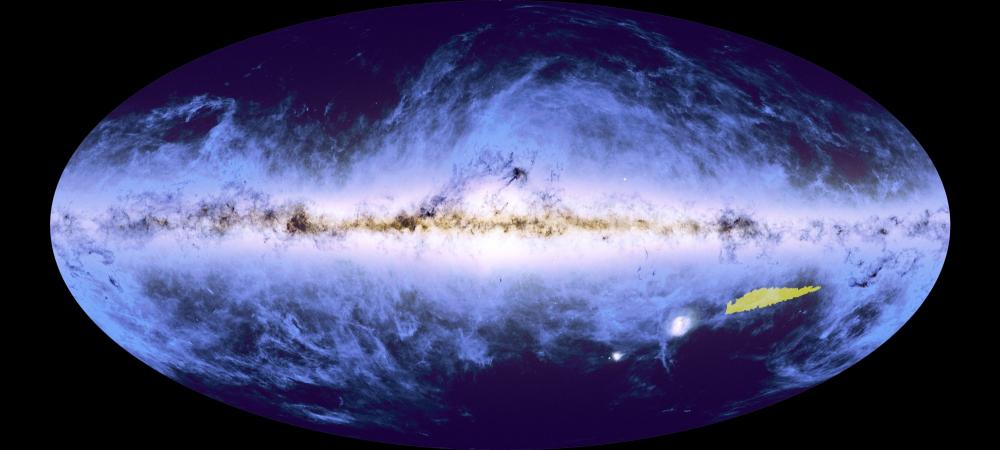
This mosaic produced by the Euclid telescope contains 260 observations collected between 25 March and 8 April 2024. It represents 1% of the vast survey that Euclid will capture over six years. In just two weeks, Euclid covered 132 square degrees of the southern sky, or more than 500 times the area of the full moon as seen from Earth.
Credits: ESA/Euclid/Euclid Consortium/NASA, CEA Paris-Saclay, image processing by J.-C. Cuillandre, E. Bertin, G. Anselmi
On 15 October, ESA's Euclid space mission revealed the first piece of its grand map of the Universe, showing millions of stars and galaxies. This first piece of Euclid's survey was revealed at the International Astronautical Congress in Milan by ESA Director General Josef Aschbacher and Director of Science Carole Mundell.
Thanks to an agreement between CEA and ESA, two experts in image processing, Jean-Charles Cuillandre and Emmanuel Bertin, both astronomers at the Observatoire des Sciences de l'Univers de Paris-Saclay (OSUPS) and members of CEA Irfu's Astrophysics Department, produced this mosaic under ESA supervision. The project's IT logistics were handled by the OSUPS Data and Operations Centre (IDOC), with technical support from the VirtualData platform at the Paris-Saclay mesocentre.
Jean-Charles Cuillandre explains: "New signal processing methods have been implemented compared to the first efforts in November 2023 and May 2024 to reveal the Universe at very low surface brightnesses down to very large scales on the sky. The wide-field, high-resolution images produced for this effort offer unprecedented homogeneity for a survey of the sky in such a spectral range from space (optical and near-infrared)."
Deep learning methods have been used by Emmanuel Bertin to eliminate the small-scale reflections of bright stars and other parasites inherent in the optics of Euclid and its instruments: "This is the first time that such an extensive image of the sky has been produced with such high resolution from space, foreshadowing the future results of this space mission. The mosaic published today is a foretaste of what the Euclid mission has in store for us in the years to come".

Top left: a map of the entire sky (41,000 square degrees)
Zone in Yellow: the Euclid mosaic; just two weeks, 1% of the vast study that Euclid will carry out over a period of six years, 132 square degrees or more than 500 times the area of the full moon.
Then 5 zooms into the smallest details
Credit: ESA/Euclid/Euclid Consortium/NASA, CEA Paris-Saclay, image processing by J.-C. Cuillandre, E. Bertin, G. Anselmi; ESA/Gaia/DPAC; ESA/Planck Collaboration CC BY-SA 3.0 IGO
In the mosaic, the locations of the different zoomed images are indicated. Above each image, the zoom factor is indicated (from 3 to 600 times compared with the original mosaic).
This mosaic already contains around 100 million sources: stars in our Milky Way and galaxies beyond. Around 14 million of these galaxies could be used to study the hidden influence of dark matter and energy on the Universe.

A map of the entire sky (41,000 square degrees) is visible, with the location of the Euclid mosaic on the southern sky highlighted in yellow.
Credits: ESA/Euclid/Euclid Consortium/NASA, CEA Paris-Saclay, image processing by J.-C. Cuillandre, E. Bertin, G. Anselmi; ESA/Gaia/DPAC; ESA/Planck Collaboration

One of the images enlarged 150 times compared with the large mosaic. This image shows galaxies interacting with each other in the Abell 3381 cluster, 420 million light years away.
Credit: ESA/Euclid/Euclid Consortium/NASA, CEA Paris-Saclay, image processing by J.-C. Cuillandre, E. Bertin, G. Anselmi
Next steps...
The first papers will be published in March 2025, based on 50 square degrees of data (the equivalent of one week), including an overview of the Euclid deep field zones (which will be observed dozens of times over the 6 years of the mission).
The first papers with a cosmological analysis and the first year of cosmological data from the mission will be released to the community in 2026.
Contacts Irfu/DAp : Jean-Charles Cuillandre, Emmanuel Bertin, Marc Sauvage
- High-definition images of ESA and CEA news
- Discover the first page of ESA's Euclid cosmic atlas and marvel at the millions of stars and galaxies captured in minute detail, in an immense mosaic of 208 gigapixels.
This video takes you on an exceptional journey through the sky. Starting with a vast cosmic panorama, a series of increasingly deep zooms brings you to a clear view of a swirling spiral galaxy, in a final image enlarged 600 times compared with the full mosaic.
Credit: ESA/Euclid/Euclid Consortium/NASA, CEA Paris-Saclay, image processing by J.-C. Cuillandre, E. Bertin, G. Anselmi; ESA/Gaia/DPAC; ESA/Planck Collaboration
• Structure and evolution of the Universe › Dark Universe
• Department of Astrophysics (DAp) // UMR AIM
• Cosmology and Galaxy Evolution
• Euclid


